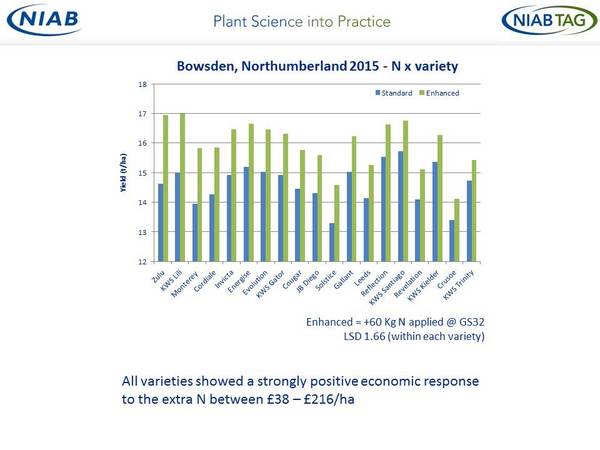Increasing nitrogen rates at GS32 to sustain high yields could be cost effective if spring conditions remain good (provided that NVZ limits permit). This is still applicable, even with current low commodity prices, but the decision needs to be science-based advises NIAB TAG.
Independent multi-site, multi-year NIAB TAG trials show an overall economic response of up to £200/ha to an extra 60 kg N/ha at GS32. However, there were site and season exceptions.
Stuart Knight, deputy director at NIAB explains that with many financial pressures on UK farmers, not least the low commodity prices, it is increasingly important to get the best return on investment from crop inputs.
If, by April, a crop has benefited from good establishment and tiller numbers, has not been adversely affected by high winter rainfall and conditions in February and March have been favourable for growth, then additional N at GS32 could be justified. But Mr Knight warns that the best approach may sometimes be to delay the timing of a particular fertiliser application.
“Optimised nutritional inputs, whether macronutrients such as N, P, K and magnesium, or micronutrients, are critical to financial success. This requires field characteristics to be taken into account, such as soil type, its ability to retain or supply nutrients and the likely deficiency issues that may arise”. Other seasonal aspects are also important such as rainfall, temperatures, crop growth and the timing of nutrient applications as well as yield expectation. “The key is to base your decision on sound science. Applying an extra bit of everything is not a panacea.”
Knowledge of the relevant legislation and codes of practice relating to nutritional inputs is also increasingly critical for both hard-headed business reasons but also environmental protection. NIAB TAG has a wealth of knowledge and expertise in crop nutrition and uses a wholly scientific and independent basis to advise on optimised crop nutrition and correct management of soils and nutritional inputs, based on unbiased research, for optimum economic returns.
This information provides the basis of the ARTIS course ‘Optimising nutrients for combinable crops’ led by Mr Knight, with places available for growers and agronomists on 25 February in Gloucestershire, 4 March in North Yorkshire and 8 March in East Sussex. For booking and further information go to www.artistraining.com.

